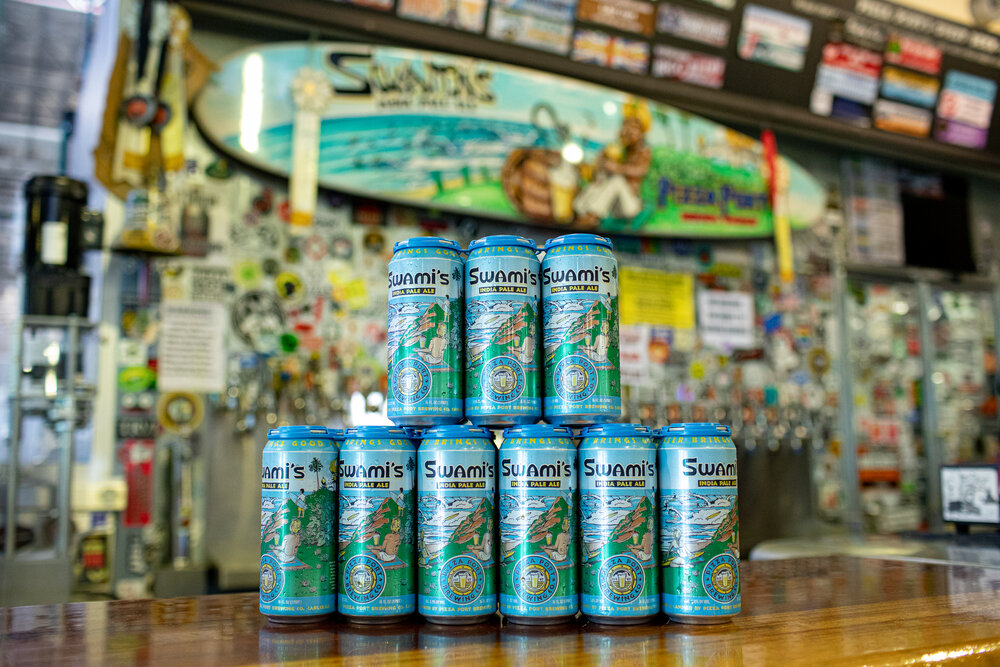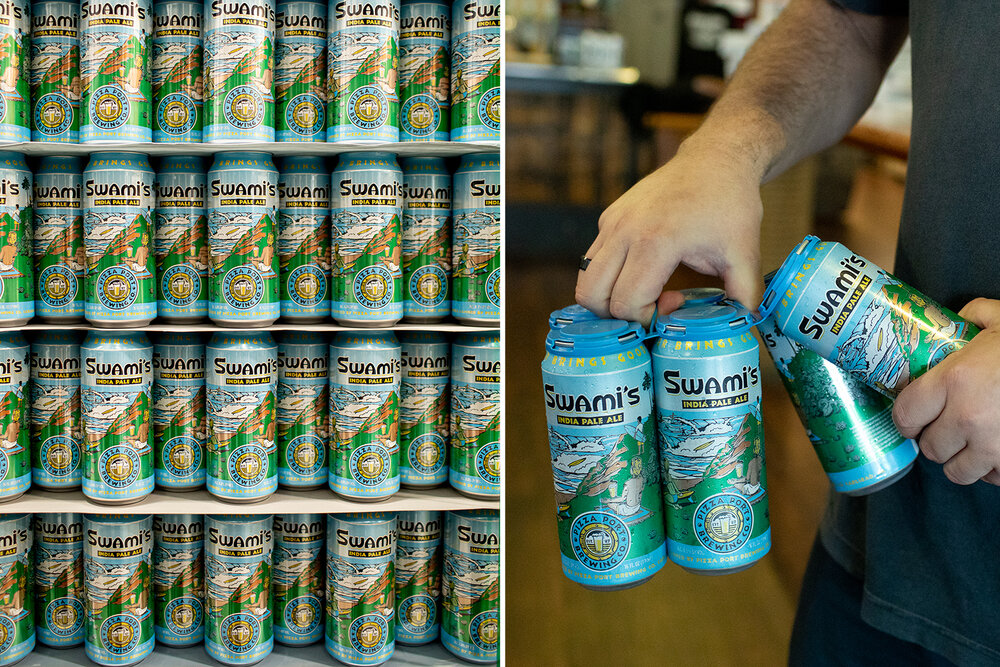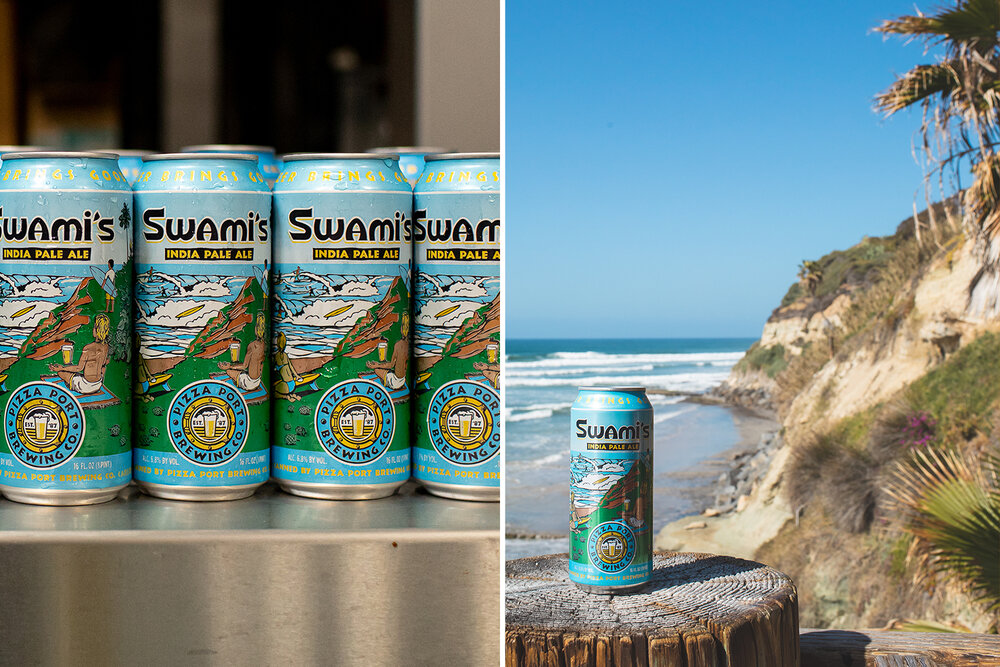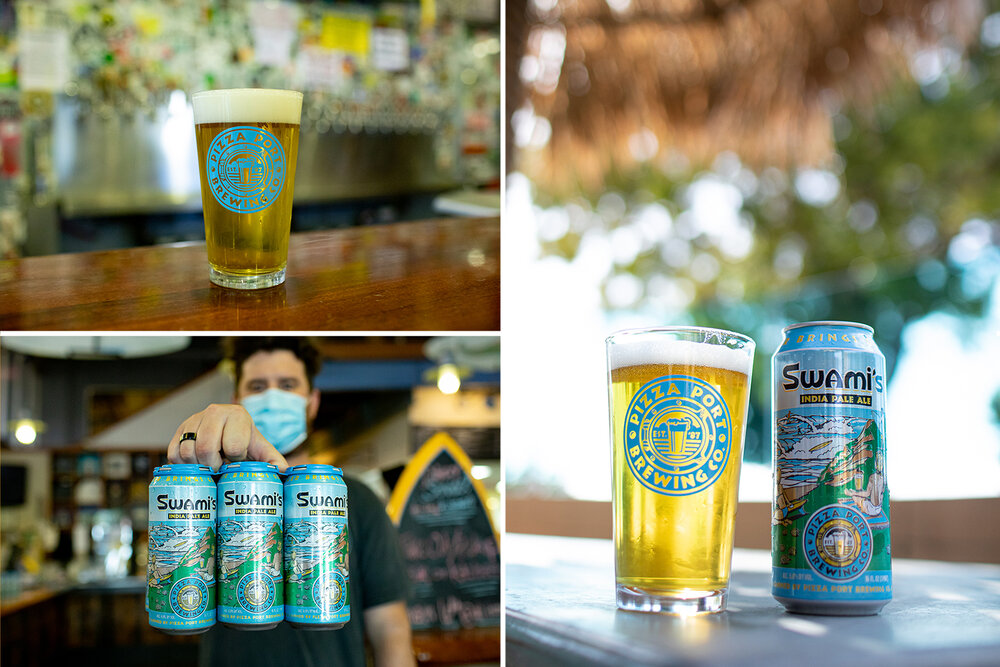Visit The Good Beer Hunting site
People—especially beer people—love arguing about what’s “best.” Who makes the best Lagers in New England? Get ready for fisticuffs. What are the best beers to drink during the holidays? I tend to go with the ones I already have in the fridge, but there’s no shortage of people on Twitter who can’t wait to tell me why I’m wrong.
But what happens if we reframe the query—if the question we ask deals with legacy and impact rather than subjective taste? For instance: Instead of the best beer in San Diego, what is the most San Diego beer?
 That’s where the real debate begins. By the numbers, there are over 3.3 million people living in San Diego County, around 150 craft breweries (give or take), and thousands of different beers available at any given time. Then there are the decades of local beer history to wade through, the titans to pay tribute to.
That’s where the real debate begins. By the numbers, there are over 3.3 million people living in San Diego County, around 150 craft breweries (give or take), and thousands of different beers available at any given time. Then there are the decades of local beer history to wade through, the titans to pay tribute to.
How do you choose? Stone Brewing’s eponymous IPA hit the scene in 1997, long before the current craft beer wave washed over California’s southernmost county. Red Trolley Ale from Karl Strauss Brewing Company has been a local mainstay since 1989. Alpine Beer Company’s Nelson helped popularize New Zealand’s now-ubiquitous Nelson Sauvin hop variety in the mid-aughts. And we can’t forget when Ballast Point Brewing Company’s Sculpin IPA took the world by storm, when AleSmith Brewing Company’s San Diego Pale Ale .394 tapped into Padre Pride, and when Islander IPA from Coronado Brewing Company melded classic C-hops into an early iteration of San Diego’s best-known export: West Coast IPAs.
One certainty: If there is a style most associated with America’s Finest City, it has to be the resinous, clear, bracingly bitter West Coast IPA. It’s probably our greatest export (though introducing the United States to fish tacos is a close second). Green Flash literally trademarked the term “West Coast IPA” in 2011, claiming early dominion over the style and name, and irrevocably tying it to San Diego.
But for me, the finalist—the ultimate San Diego beer—is an easy pick: Swami’s IPA from Pizza Port Brewing Company.

 It’s not just that the 6.8% IPA bursts with New World hop personality, as any archetype of the style should. Sure, it has a rich scent of citrus fruit and dank pine that culminates in a smooth, crisp, dry finish. Its lasting impression is aggressively bitter, but it somehow remains bright and clean without astringency, or much personality coming from either the yeast or malt. In true West Coast style, Swami’s is clear, and pours with a fluffy white foam nestled on top of the sparkling, daffodil-yellow liquid. Even the can art encapsulates the soul of San Diego: That is, cold beers and tasty waves.
It’s not just that the 6.8% IPA bursts with New World hop personality, as any archetype of the style should. Sure, it has a rich scent of citrus fruit and dank pine that culminates in a smooth, crisp, dry finish. Its lasting impression is aggressively bitter, but it somehow remains bright and clean without astringency, or much personality coming from either the yeast or malt. In true West Coast style, Swami’s is clear, and pours with a fluffy white foam nestled on top of the sparkling, daffodil-yellow liquid. Even the can art encapsulates the soul of San Diego: That is, cold beers and tasty waves.
A BRIEF HISTORY OF SWAMI'S In 1987, siblings Gina and Vince Marsaglia took over a hole-in-the-wall pizza parlor a block away from the Pacific Ocean in the laidback city of Solana Beach, smack in the center of San Diego County’s coastline. Part pizzeria, part crash pad for the pair—and an occasional surfboard repair shop—the restaurant saw the two sling pizzas by day while Vince homebrewed by night. Eventually, Pizza Port transformed into a fully fledged brewpub in 1992, 10 years after they were legalized in California. The humble space, crowded with communal benches and surf-rat-style art, quickly became a magnet for loyal beer fans and brewers, many of whom cite Swami’s as early inspiration for their own brewing endeavors.
 “There were certainly other IPAs, but nothing with a flavor profile like Swami’s,” says Vinnie Cilurzo, owner and brewer at Russian River Brewing Company in Santa Rosa, California. “Vince was quite helpful to me when it came to me extrapolating up my homebrew IPA recipe to a commercial-batch-sized recipe, which became Blind Pig IPA. In fact, I remember Vince giving me the exact Swami’s recipe and saying, ‘Here, use it as a guide, I know you won’t copy it as you have your own recipe already.’ So I did.”
“There were certainly other IPAs, but nothing with a flavor profile like Swami’s,” says Vinnie Cilurzo, owner and brewer at Russian River Brewing Company in Santa Rosa, California. “Vince was quite helpful to me when it came to me extrapolating up my homebrew IPA recipe to a commercial-batch-sized recipe, which became Blind Pig IPA. In fact, I remember Vince giving me the exact Swami’s recipe and saying, ‘Here, use it as a guide, I know you won’t copy it as you have your own recipe already.’ So I did.”
“There were certainly other IPAs, but nothing with a flavor profile like Swami’s. Vince was quite helpful to me when it came to me extrapolating up my homebrew IPA recipe to a commercial-batch-sized recipe, which became Blind Pig IPA. In fact, I remember Vince giving me the exact Swami’s recipe and saying, ‘Here, use it as a guide, I know you won’t copy it as you have your own recipe already.’ So I did.”
— Vinnie Cilurzo, Russian River Brewing CompanyAnother early San Diego beer trailblazer, Chris Cramer—CEO and co-founder of Karl Strauss—recalls a similar first encounter. “I remember tasting Swami’s with my business partner Matt Rattner when it first came out and finding it to be bracingly assertive and borderline assaultive to the palate, but brilliantly crafted and seductively and irresistibly delicious,” he says. “It was so different and ‘out there’ that we questioned whether it could ever find a market beyond the small number of homebrewers, beer geeks, and hop heads that existed at the time. Obviously, that market was larger than we thought, and it has grown enormously since 1992.”
Though Pizza Port began humbly, its early impact on the burgeoning California craft beer scene is hard to overstate. “They were always on the cutting edge in that they didn’t just sit back and ride on a few solidly made beers,” says Chuck Silva, former brewmaster at Green Flash and now the co-founder and brewmaster at Silva Brewing in Paso Robles, California. Based on the number of accolades Pizza Port has earned over the years—including nearly 100 medals from the Great American Beer Festival alone, by Gina’s best approximation—it’s clear that the humble, beachside brewpub has immeasurably influenced a generation of West Coast-centric brewers, and helped nurture the evolving demand for hop-led brews.

 “There are a lot of people out there that immediately think ‘IPA’ when they hear ‘craft beer’ or ‘San Diego beer,’” says Jill Olesh, senior sales and brand development manager at Pizza Port. “I like to think that Swami’s had a role in that.” Gina hopes so as well. “So many brewers have visited Pizza Port locations since we opened our doors. I have to believe that the vision of Swami’s as being one of the OG IPAs brewed in the great town hopefully inspired many others to go back home and make a kick-ass IPA.”
“There are a lot of people out there that immediately think ‘IPA’ when they hear ‘craft beer’ or ‘San Diego beer,’” says Jill Olesh, senior sales and brand development manager at Pizza Port. “I like to think that Swami’s had a role in that.” Gina hopes so as well. “So many brewers have visited Pizza Port locations since we opened our doors. I have to believe that the vision of Swami’s as being one of the OG IPAs brewed in the great town hopefully inspired many others to go back home and make a kick-ass IPA.”
After the original brewpub opened in 1987, numerous outposts followed: Carlsbad in 1997 (a bottle shop opened next to that location in 2008), San Clemente in 2003, Ocean Beach in 2010, and Bressi Ranch in 2013, the last of which now also houses a corporate office, production brewery, and canning line. The brewpubs operate semi-autonomously, with different head brewers at each post, each of whom has the ability to brew small batches for their respective locations.
But Swami’s has remained a staple across the company, especially bolstered by the fact it was the first regularly packaged and distributed beer released by the brewery side of the business. “When the decision to build Bressi [Ranch] and start canning happened, there were a large number of amazing IPAs from the Pizza Port vault that we could have chosen to be the flagship canned IPA,” says Sean Farrell, Pizza Port’s director of brewing. “But [due to the] iconic status Swami’s IPA held in our company, and also the iconic imagery of the place itself in San Diego, made it a pretty easy decision.”
 Pizza Port first released Swami’s in cans in January 2014, and it has been a number-one seller for the brewery since then by “a large margin,” according to Gina. She estimates that, through its distribution channels across the southwestern United States, the brewery sells three times more Swami’s than its next best-seller, Chronic Ale, a 4.9% ABV Amber Ale.
Pizza Port first released Swami’s in cans in January 2014, and it has been a number-one seller for the brewery since then by “a large margin,” according to Gina. She estimates that, through its distribution channels across the southwestern United States, the brewery sells three times more Swami’s than its next best-seller, Chronic Ale, a 4.9% ABV Amber Ale.
“So many brewers have visited Pizza Port locations since we opened our doors. I have to believe that the vision of Swami’s as being one of the OG IPAs brewed in the great town hopefully inspired many others to go back home and make a kick-ass IPA.”
— Gina Marsaglia, Pizza Port Brewing Company“Swami’s accounts for about 40% of the beer we make and sell out of the production brewery, which is a pretty dominant volume in our overall mix,” says Olesh. “At any given point in time, at least four-to-five of our tanks have Swami’s in [them], and we package it weekly […] it’s worth noting that 20% of the mix is our line of seasonal IPAs, so roughly 60% of the beer we brew and package are IPAs.” Despite COVID-19’s disruption to on-premise sales, Swami’s as an overall brand still grew 11% in 2020, she says.
EVOLUTION OF AN ICON If you ever have a question about beer, domestic or not, it’s always a good idea to ask Gene Fielden, the longtime manager and beer buyer at Bottlecraft North Park. When I asked him which beer he thinks best represents San Diego, he gave me the same answer he says he gives anyone who asks that question: “Swami’s!”
 “With two of the classic ‘C’-hops—Cascade and Centennial—perched atop a clean malt base like the snake-charmer so cheekily depicted on the can’s label, it balances bitterness and restraint at once,” explains Fielden. “Its 6.8% ABV falls right into the zone of the best single IPAs—neither too hefty for Pale Ale drinkers nor too lightweight for those who prefer DIPAs […] Whenever a bike ride takes me out to Pizza Port Ocean Beach, I usually scan the expansive menu and then order a Swami’s as the first round, as though that hadn’t been the foregone conclusion all along.”
“With two of the classic ‘C’-hops—Cascade and Centennial—perched atop a clean malt base like the snake-charmer so cheekily depicted on the can’s label, it balances bitterness and restraint at once,” explains Fielden. “Its 6.8% ABV falls right into the zone of the best single IPAs—neither too hefty for Pale Ale drinkers nor too lightweight for those who prefer DIPAs […] Whenever a bike ride takes me out to Pizza Port Ocean Beach, I usually scan the expansive menu and then order a Swami’s as the first round, as though that hadn’t been the foregone conclusion all along.”
But the current iteration of Swami’s has evolved quite a bit from its original ’90s recipe, when it was the second batch ever brewed at the Solana Beach brewpub after Shark Bite Red Ale. “My understanding from Vince, who was the brewer, is that the goal was to brew a souped-up Sierra Pale,” explains Farrell.
“Whenever a bike ride takes me out to Pizza Port Ocean Beach, I usually scan the expansive menu and then order a Swami’s as the first round, as though that hadn’t been the foregone conclusion all along.”
— Gene Fielden, Bottlecraft North ParkAccording to Gina, the earliest version included two-row, Carapils, and 80L crystal malt, with Galena, Centennial, and Cascade hops, and was fermented with California Ale Yeast. “It was a beast of an IPA with robust bitterness and over 7% ABV,” she says. “Tomme [Arthur, former Pizza Port head brewer and now co-founder and CEO of The Lost Abbey] tweaked the recipe a little bit when he arrived in Solana Beach in 1997. He dropped the 80L crystal to 60L, lightening the color slightly, and emphasized a bit longer time on the dry hops, which remained a mix of Centennial and Cascade.”
The recipe remained the same until 2013, when Farrell launched the Bressi Ranch brewhouse and realized the beloved brand badly needed an update to make the beer crisper, drier, more hop-forward, and with a slightly lower ABV. “You get there by simplifying the grain bill [now almost all two-row] and using a lower mash temp,” he says. “Because there was no rich caramel flavor to balance the hop bitterness, bittering levels were brought down to balance the beer. We knew we had to keep the classic Cascade and Centennial in there, but decided to add some newer, ‘brighter’ hops, Citra and Simcoe. Both Citra and Simcoe have citrus and pine elements, but also bring in some tropical, brighter, and [more] modern elements. There is also little bit of Chinook [and CTZ] in the current beer.”
Successfully evolving Swami’s alongside consumer tastes while ensuring the beer remained a go-to for stalwart craft beer drinkers was far from a given for Pizza Port. “It’s clearly changed with the times, and I think that’s the smart thing—they’ve given it a modern update and it is representative of the changes the San Diego beer scene has gone through,” says Silva.

 In early 2021, Swami’s will go through yet another overhaul, but just on the outside. The beer’s name comes from the popular surf break, also called Swami’s, in nearby Encinitas, located below the cliffs where the Self-Realization Fellowship (SRF) ashram sits. Founded by Paramahansa Yogananda (sometimes called Swami Paramahansa Yogananda), the recognizable landmark has graced the can art since its inception, along with the iconic surf break, swaying palm trees, and a monk of the SRF monastic order.
In early 2021, Swami’s will go through yet another overhaul, but just on the outside. The beer’s name comes from the popular surf break, also called Swami’s, in nearby Encinitas, located below the cliffs where the Self-Realization Fellowship (SRF) ashram sits. Founded by Paramahansa Yogananda (sometimes called Swami Paramahansa Yogananda), the recognizable landmark has graced the can art since its inception, along with the iconic surf break, swaying palm trees, and a monk of the SRF monastic order.
The current can art, which features a cartoon depiction of a turbaned snake charmer, feels undoubtedly cringey, and it’s hard to talk about Swami’s without acknowledging the beer’s outdated and Orientalist choice of can art. That said, the brewery will soon debut a new can design, one with yogis perched atop the same cliffs, communing with the Pacific Ocean and enjoying pints of the golden liquid with a westward gaze.
It’s a welcome change, and one that fits with the Pizza Port ethos—constantly tweaking, finessing, improving, and perfecting their practice through self-realization, just like those clifftop yogis.
REFLECTIONS AND PREDICTIONS “If you’ve ever drank a Swami’s with either one of them [Gina or Vince], you will have warm-and-fuzzies about that beer forever,” says Olesh. “Swami’s was genuinely the beer they wanted to drink almost 30 years ago, and it’s still the beer they want to drink now.”
 Today, the siblings still run the modest Pizza Port empire together, with Gina focusing on big-picture changes while Vince takes on more of the day-to-day operations. But Swami’s has remained a consistent standby over the decades, for both the Marsaglias and the San Diego beer community at large. “San Diego went from a crazy light beer town to being consistently recognized as one of the top three—if not the best—places to visit for craft beer,” says Gina. “That took 20 short and sweet years, but it was something to see.”
Today, the siblings still run the modest Pizza Port empire together, with Gina focusing on big-picture changes while Vince takes on more of the day-to-day operations. But Swami’s has remained a consistent standby over the decades, for both the Marsaglias and the San Diego beer community at large. “San Diego went from a crazy light beer town to being consistently recognized as one of the top three—if not the best—places to visit for craft beer,” says Gina. “That took 20 short and sweet years, but it was something to see.”
The longevity of Swami’s is thanks to Pizza Port’s reputation as a brewery, but a little bit of “right place, right time” as well, as Olesh puts it. “It’s kind of one of the Founding Figures of IPAs, you know? It was a good pulse check or temperature gauge for brewers as West Coast-style IPAs grew in popularity.”
Another pioneer in San Diego beer, Greg Koch of Stone Brewing, recalls his initial impression of the beer when he lived near the Solana Beach brewpub in the mid ’90s. “Who knows how many pints over that year I had? But it was many. It was my go-to beer. I had Swami’s more often than anything else, because it just hit my personal flavor profile […] It helped form what I really liked in beer. Funny enough, it didn’t seem so groundbreaking to me at the time. It just seemed like a great beer that I loved.”
“It was just such a joy to be able to have Swami’s in the earlier days. It just feels like home to me. I can look back in sepia-toned memories, but it was a time when craft beer wasn’t a thing. It was kind of a lonely outpost for craft beer, where you would know all the good spots around San Diego where you could enjoy a good beer […] I can really wax poetically about it.”
— Greg Koch, Stone BrewingLater in our conversation, Koch reflected on those nascent days in the local craft beer scene, and how Pizza Port acted as a magnetic force in a region that would go on to become a powerhouse of craft beer. “It was just such a joy to be able to have Swami’s in the earlier days,” he says. “It just feels like home to me. I can look back in sepia-toned memories, but it was a time when craft beer wasn’t a thing. It was kind of a lonely outpost for craft beer, where you would know all the good spots around San Diego where you could enjoy a good beer […] I can really wax poetically about it. It’s just time, it’s experiences, it’s conversations, and it’s many pints of beer and great pizza. The face you’d see there, knowing them over the years, it’s fun. I love Pizza Port.” He laughs. “I wish I was there now!”
 I know the feeling. From birthdays to baby showers, I’ve spent many, many celebratory occasions at various Pizza Ports, most often in Ocean Beach. My pizza order has been the same for over a decade: a half Vallarta (Canadian-style bacon, olives, jalapeños, hold the onions), half Carlsbad (pesto, mesquite grilled chicken, sun-dried tomatoes, artichoke hearts, and feta cheese). If I’m feeling extra peckish, an order of garlic Beer Buddies to share as well.
I know the feeling. From birthdays to baby showers, I’ve spent many, many celebratory occasions at various Pizza Ports, most often in Ocean Beach. My pizza order has been the same for over a decade: a half Vallarta (Canadian-style bacon, olives, jalapeños, hold the onions), half Carlsbad (pesto, mesquite grilled chicken, sun-dried tomatoes, artichoke hearts, and feta cheese). If I’m feeling extra peckish, an order of garlic Beer Buddies to share as well.
Even though there are always tempting guest beers on draft, when I’m at Pizza Port, I’m drinking Pizza Port beer. If it’s not a pitcher of Swami’s for the table, it’s a pint of Skid Mark English Mild Ale, Bacon & Eggs Imperial Coffee Porter, or its Session IPA, Ponto (if I have to drive). Some people don’t like the democratic nature of Pizza Port’s communal tables, or the pervasive screams of children utilizing the arcade games and Big Buck Hunter. But I’d be lying if I said I didn’t miss sitting shoulder to shoulder with a stranger, waves of joy washing over every person sharing the same collective moment.
 The original Solana Beach location is a time capsule, clinging to nostalgia for the nascent days of the San Diego craft beer scene while continuing to mature with the industry it helped build. By simply trying to make the beer they wanted to drink, the Marsaglias managed to make something that pretty much everyone enjoys. I often joke that if you live in San Diego, it’s just a matter of time until you learn to love hoppy beers, because that’s just what’s available.
The original Solana Beach location is a time capsule, clinging to nostalgia for the nascent days of the San Diego craft beer scene while continuing to mature with the industry it helped build. By simply trying to make the beer they wanted to drink, the Marsaglias managed to make something that pretty much everyone enjoys. I often joke that if you live in San Diego, it’s just a matter of time until you learn to love hoppy beers, because that’s just what’s available.
“Swami’s has remained a classic and much-beloved beer over so many years because it is a truly great IPA,” says Cramer. “[It] changed the course of brewing in San Diego, inspired other local brewers in their IPA formulations, and started an arc towards brewing more hop-forward beers which ultimately made our fair city the IPA capital of the world.” That’s a lofty claim, but I’d wager all it would take to convince the skeptics is one sip of the perpetual darling.

 Words by Beth Demmon
Words by Beth Demmon
Photos by Arlene Ibarra
More...
That’s where the real debate begins. By the numbers, there are over 3.3 million people living in San Diego County, around 150 craft breweries (give or take), and thousands of different beers available at any given time. Then there are the decades of local beer history to wade through, the titans to pay tribute to.

It’s not just that the 6.8% IPA bursts with New World hop personality, as any archetype of the style should. Sure, it has a rich scent of citrus fruit and dank pine that culminates in a smooth, crisp, dry finish. Its lasting impression is aggressively bitter, but it somehow remains bright and clean without astringency, or much personality coming from either the yeast or malt. In true West Coast style, Swami’s is clear, and pours with a fluffy white foam nestled on top of the sparkling, daffodil-yellow liquid. Even the can art encapsulates the soul of San Diego: That is, cold beers and tasty waves.
“There were certainly other IPAs, but nothing with a flavor profile like Swami’s,” says Vinnie Cilurzo, owner and brewer at Russian River Brewing Company in Santa Rosa, California. “Vince was quite helpful to me when it came to me extrapolating up my homebrew IPA recipe to a commercial-batch-sized recipe, which became Blind Pig IPA. In fact, I remember Vince giving me the exact Swami’s recipe and saying, ‘Here, use it as a guide, I know you won’t copy it as you have your own recipe already.’ So I did.”

“There are a lot of people out there that immediately think ‘IPA’ when they hear ‘craft beer’ or ‘San Diego beer,’” says Jill Olesh, senior sales and brand development manager at Pizza Port. “I like to think that Swami’s had a role in that.” Gina hopes so as well. “So many brewers have visited Pizza Port locations since we opened our doors. I have to believe that the vision of Swami’s as being one of the OG IPAs brewed in the great town hopefully inspired many others to go back home and make a kick-ass IPA.”
Pizza Port first released Swami’s in cans in January 2014, and it has been a number-one seller for the brewery since then by “a large margin,” according to Gina. She estimates that, through its distribution channels across the southwestern United States, the brewery sells three times more Swami’s than its next best-seller, Chronic Ale, a 4.9% ABV Amber Ale.
“With two of the classic ‘C’-hops—Cascade and Centennial—perched atop a clean malt base like the snake-charmer so cheekily depicted on the can’s label, it balances bitterness and restraint at once,” explains Fielden. “Its 6.8% ABV falls right into the zone of the best single IPAs—neither too hefty for Pale Ale drinkers nor too lightweight for those who prefer DIPAs […] Whenever a bike ride takes me out to Pizza Port Ocean Beach, I usually scan the expansive menu and then order a Swami’s as the first round, as though that hadn’t been the foregone conclusion all along.”

In early 2021, Swami’s will go through yet another overhaul, but just on the outside. The beer’s name comes from the popular surf break, also called Swami’s, in nearby Encinitas, located below the cliffs where the Self-Realization Fellowship (SRF) ashram sits. Founded by Paramahansa Yogananda (sometimes called Swami Paramahansa Yogananda), the recognizable landmark has graced the can art since its inception, along with the iconic surf break, swaying palm trees, and a monk of the SRF monastic order.
Today, the siblings still run the modest Pizza Port empire together, with Gina focusing on big-picture changes while Vince takes on more of the day-to-day operations. But Swami’s has remained a consistent standby over the decades, for both the Marsaglias and the San Diego beer community at large. “San Diego went from a crazy light beer town to being consistently recognized as one of the top three—if not the best—places to visit for craft beer,” says Gina. “That took 20 short and sweet years, but it was something to see.”
I know the feeling. From birthdays to baby showers, I’ve spent many, many celebratory occasions at various Pizza Ports, most often in Ocean Beach. My pizza order has been the same for over a decade: a half Vallarta (Canadian-style bacon, olives, jalapeños, hold the onions), half Carlsbad (pesto, mesquite grilled chicken, sun-dried tomatoes, artichoke hearts, and feta cheese). If I’m feeling extra peckish, an order of garlic Beer Buddies to share as well.
The original Solana Beach location is a time capsule, clinging to nostalgia for the nascent days of the San Diego craft beer scene while continuing to mature with the industry it helped build. By simply trying to make the beer they wanted to drink, the Marsaglias managed to make something that pretty much everyone enjoys. I often joke that if you live in San Diego, it’s just a matter of time until you learn to love hoppy beers, because that’s just what’s available.
Words by Beth Demmon





 Reply With Quote
Reply With Quote